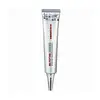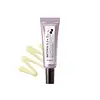What's inside
What's inside
 Key Ingredients
Key Ingredients

 Benefits
Benefits

 Concerns
Concerns

 Ingredients Side-by-side
Ingredients Side-by-side

Panax Ginseng Callus Culture Extract
Skin ConditioningAspergillus/Rice Ferment Filtrate
Skin ConditioningButylene Glycol
HumectantStearic Acid
CleansingGlycerin
HumectantDicaprylyl Carbonate
EmollientNiacinamide
Smoothing1,2-Hexanediol
Skin ConditioningLactobacillus/Lemon Peel Ferment Extract
Skin ConditioningCitrus Aurantium Dulcis Peel Extract
Emulsion StabilisingSh-Polypeptide-11
Sh-Oligopeptide-2
Skin ConditioningAcetyl Hexapeptide-8
HumectantHexapeptide-12
Skin ConditioningPolyglyceryl-3 Stearate
EmulsifyingCetearyl Olivate
Betaine
HumectantSodium Hyaluronate
HumectantPalmitoyl Tripeptide-5
Skin ConditioningCopper Tripeptide-1
Skin ConditioningSorbitan Laurate
EmulsifyingHydroxyethylcellulose
Emulsion StabilisingAcetyl Dipeptide-1 Cetyl Ester
Skin ConditioningGinsenosides
Skin ConditioningColloidal Platinum
AntimicrobialHydrolyzed Collagen
EmollientPunica Granatum Fruit Extract
AntioxidantFicus Carica Fruit Extract
HumectantMorus Alba Fruit Extract
AntioxidantGinkgo Biloba Nut Extract
Skin ConditioningArnica Montana Flower Extract
MaskingArtemisia Absinthium Extract
Skin ConditioningAchillea Millefolium Extract
CleansingGentiana Lutea Root Extract
Skin ConditioningChamomilla Recutita Flower Extract
MaskingPolyglutamic Acid
Skin ConditioningAscorbyl Glucoside
AntioxidantGrifola Frondosa Fruiting Body Extract
EmollientMaltodextrin
AbsorbentMagnolia Kobus Bark Extract
Skin ConditioningHydrolyzed Hyaluronic Acid
HumectantBiosaccharide Gum-1
HumectantDipeptide Diaminobutyroyl Benzylamide Diacetate
Skin ConditioningBeta-Glucan
Skin ConditioningCamellia Japonica Seed Oil
EmollientTocopherol
AntioxidantCarbomer
Emulsion StabilisingAllantoin
Skin ConditioningArginine
MaskingLavandula Angustifolia Oil
MaskingBoswellia Carterii Oil
MaskingCitrus Aurantium Dulcis Peel Oil
MaskingCitrus Nobilis Peel Oil
MaskingAdenosine
Skin ConditioningPanax Ginseng Callus Culture Extract, Aspergillus/Rice Ferment Filtrate, Butylene Glycol, Stearic Acid, Glycerin, Dicaprylyl Carbonate, Niacinamide, 1,2-Hexanediol, Lactobacillus/Lemon Peel Ferment Extract, Citrus Aurantium Dulcis Peel Extract, Sh-Polypeptide-11, Sh-Oligopeptide-2, Acetyl Hexapeptide-8, Hexapeptide-12, Polyglyceryl-3 Stearate, Cetearyl Olivate, Betaine, Sodium Hyaluronate, Palmitoyl Tripeptide-5, Copper Tripeptide-1, Sorbitan Laurate, Hydroxyethylcellulose, Acetyl Dipeptide-1 Cetyl Ester, Ginsenosides, Colloidal Platinum, Hydrolyzed Collagen, Punica Granatum Fruit Extract, Ficus Carica Fruit Extract, Morus Alba Fruit Extract, Ginkgo Biloba Nut Extract, Arnica Montana Flower Extract, Artemisia Absinthium Extract, Achillea Millefolium Extract, Gentiana Lutea Root Extract, Chamomilla Recutita Flower Extract, Polyglutamic Acid, Ascorbyl Glucoside, Grifola Frondosa Fruiting Body Extract, Maltodextrin, Magnolia Kobus Bark Extract, Hydrolyzed Hyaluronic Acid, Biosaccharide Gum-1, Dipeptide Diaminobutyroyl Benzylamide Diacetate, Beta-Glucan, Camellia Japonica Seed Oil, Tocopherol, Carbomer, Allantoin, Arginine, Lavandula Angustifolia Oil, Boswellia Carterii Oil, Citrus Aurantium Dulcis Peel Oil, Citrus Nobilis Peel Oil, Adenosine
Water
Skin ConditioningButylene Glycol
HumectantGlycerin
HumectantCetearyl Alcohol
EmollientCetearyl Olivate
Niacinamide
Smoothing1,2-Hexanediol
Skin ConditioningSorbitan Olivate
EmulsifyingTriethylhexanoin
MaskingHelianthus Annuus Seed Oil
EmollientCaprylic/Capric Triglyceride
MaskingCyclohexasiloxane
EmollientEthylhexyl Olivate
Skin ConditioningPolysorbate 60
EmulsifyingHippophae Rhamnoides Fruit Oil
Skin ProtectingHydroxyethyl Acrylate/Sodium Acryloyldimethyl Taurate Copolymer
Emulsion StabilisingSodium Acrylates Copolymer
Dimethicone/Vinyl Dimethicone Crosspolymer
Skin ConditioningPoloxamer 235
EmulsifyingPolyglyceryl-4 Oleate
EmulsifyingPrunus Serotina Fruit Extract
MaskingXanthan Gum
EmulsifyingRetinol
Skin ConditioningPanthenol
Skin ConditioningBetaine
HumectantAllantoin
Skin ConditioningPolysorbate 20
EmulsifyingSodium Ascorbate
AntioxidantEctoin
Skin ConditioningAdenosine
Skin ConditioningEpigallocatechin Gallate
AntioxidantRosmarinus Officinalis Leaf Oil
MaskingSorbitan Isostearate
EmulsifyingBakuchiol
AntimicrobialBHT
AntioxidantDisodium EDTA
Ceramide NP
Skin ConditioningHydrogenated Lecithin
EmulsifyingBHA
AntioxidantGlyceryl Stearate
EmollientDipropylene Glycol
HumectantSodium Hyaluronate
HumectantGlutathione
Sodium Guaiazulene Sulfonate
Calendula Officinalis Flower Extract
MaskingWater, Butylene Glycol, Glycerin, Cetearyl Alcohol, Cetearyl Olivate, Niacinamide, 1,2-Hexanediol, Sorbitan Olivate, Triethylhexanoin, Helianthus Annuus Seed Oil, Caprylic/Capric Triglyceride, Cyclohexasiloxane, Ethylhexyl Olivate, Polysorbate 60, Hippophae Rhamnoides Fruit Oil, Hydroxyethyl Acrylate/Sodium Acryloyldimethyl Taurate Copolymer, Sodium Acrylates Copolymer, Dimethicone/Vinyl Dimethicone Crosspolymer, Poloxamer 235, Polyglyceryl-4 Oleate, Prunus Serotina Fruit Extract, Xanthan Gum, Retinol, Panthenol, Betaine, Allantoin, Polysorbate 20, Sodium Ascorbate, Ectoin, Adenosine, Epigallocatechin Gallate, Rosmarinus Officinalis Leaf Oil, Sorbitan Isostearate, Bakuchiol, BHT, Disodium EDTA, Ceramide NP, Hydrogenated Lecithin, BHA, Glyceryl Stearate, Dipropylene Glycol, Sodium Hyaluronate, Glutathione, Sodium Guaiazulene Sulfonate, Calendula Officinalis Flower Extract
Ingredients Explained
These ingredients are found in both products.
Ingredients higher up in an ingredient list are typically present in a larger amount.
1,2-Hexanediol is a synthetic liquid and another multi-functional powerhouse.
It is a:
- Humectant, drawing moisture into the skin
- Emollient, helping to soften skin
- Solvent, dispersing and stabilizing formulas
- Preservative booster, enhancing the antimicrobial activity of other preservatives
Adenosine is in every living organism. It is one of four components in nucleic acids that helps store our DNA.
Adenosine has many benefits when used. These benefits include hydrating the skin, smoothing skin, and reducing wrinkles. Once applied, adenosine increases collagen production. It also helps with improving firmness and tissue repair.
Studies have found adenosine may also help with wound healing.
In skincare products, Adenosine is usually derived from yeast.
Learn more about AdenosineAllantoin is a soothing ingredient known for its protective and moisturizingg properties. Because of this, it is often added to products with strong active ingredients.
Studies show higher concentrations of this ingredient can promote wound healing.
Though it can be derived from the comfrey plant, allantoin is produced synthetically for cosmetic products to ensure purity.
Learn more about AllantoinBetaine is a common humectant (a substance that promotes retention of moisture). It's known to be gentle on the skin and can help balance hydration.
This ingredient is best for improving hydration and soothing irritated skin. Studies also show it helps even out skin tone.
Fun fact: Betaine is naturally created in the skin and body. The kind found within cosmetic products can be either plant-derived or synthetic.
Another name for betaine is trimethylglycine.
Learn more about BetaineButylene Glycol (or BG) is used within cosmetic products for a few different reasons:
Overall, Butylene Glycol is a safe and well-rounded ingredient that works well with other ingredients.
Though this ingredient works well with most skin types, some people with sensitive skin may experience a reaction such as allergic rashes, closed comedones, or itchiness.
Learn more about Butylene GlycolCetearyl Olivate is an emulsifier and texture enhancer. It is derived from the fatty acids of olive oil and Cetearyl alcohol, and is biodegradable.
As an emulsifier, it is used to prevent oils and waters from separating. It can also
Manufacturers use the name Olivem 1000. This ingredient has been found to preserve the natural microbiome of skin. Having a healthy microbiome helps keep our skin healthy and protects against harmful bacteria. This ingredient is grouped with Sorbitan Olivate under the name Olivem 1000.
Learn more about Cetearyl OlivateGlycerin is already naturally found in your skin. It helps moisturize and protect your skin.
A study from 2016 found glycerin to be more effective as a humectant than AHAs and hyaluronic acid.
As a humectant, it helps the skin stay hydrated by pulling moisture to your skin. The low molecular weight of glycerin allows it to pull moisture into the deeper layers of your skin.
Hydrated skin improves your skin barrier; Your skin barrier helps protect against irritants and bacteria.
Glycerin has also been found to have antimicrobial and antiviral properties. Due to these properties, glycerin is often used in wound and burn treatments.
In cosmetics, glycerin is usually derived from plants such as soybean or palm. However, it can also be sourced from animals, such as tallow or animal fat.
This ingredient is organic, colorless, odorless, and non-toxic.
Glycerin is the name for this ingredient in American English. British English uses Glycerol/Glycerine.
Learn more about GlycerinNiacinamide is a multitasking form of vitamin B3 that strengthens the skin barrier, reduces pores and dark spots, regulates oil, and improves signs of aging.
And the best part? It's gentle and well-tolerated by most skin types, including sensitive and reactive skin.
You might have heard of "niacin flush", or the reddening of skin that causes itchiness. Niacinamide has not been found to cause this.
In very rare cases, some individuals may not be able to tolerate niacinamide at all or experience an allergic reaction to it.
If you are experiencing flaking, irritation, and dryness with this ingredient, be sure to double check all your products as this ingredient can be found in all categories of skincare.
When incorporating niacinamide into your routine, look out for concentration amounts. Typically, 5% niacinamide provides benefits such as fading dark spots. However, if you have sensitive skin, it is better to begin with a smaller concentration.
When you apply niacinamide to your skin, your body converts it into nicotinamide adenine dinucleotide (NAD). NAD is an essential coenzyme that is already found in your cells as "fuel" and powers countless biological processes.
In your skin, NAD helps repair cell damage, produce new healthy cells, support collagen production, strengthen the skin barrier, and fight environmental stressors (like UV and pollution).
Our natural NAD levels start to decline with age, leading to slower skin repair, visible aging, and a weaker skin barrier. By providing your skin niacinamide, you're recharging your skin's NAD levels. This leads to stronger, healthier, and younger looking skin.
Another name for vitamin B3 is nicotinamide. This vitamin is water-soluble and our bodies don't store it. We obtain Vitamin B3 from either food or skincare. Meat, fish, wheat, yeast, and leafy greens contain vitamin B3.
The type of niacinamide used in skincare is synthetically created.
Learn more about NiacinamideSodium Hyaluronate is hyaluronic acid's salt form. It is commonly derived from the sodium salt of hyaluronic acid.
Like hyaluronic acid, it is great at holding water and acts as a humectant. This makes it a great skin hydrating ingredient.
Sodium Hyaluronate is naturally occurring in our bodies and is mostly found in eye fluid and joints.
These are some other common types of Hyaluronic Acid:
Learn more about Sodium Hyaluronate